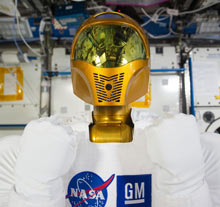Safer robots will improve manufacturing
July 14, 2011 | Source: Technology Review

Robonaut 2 (credit: NASA)
Robots have been considered too unpredictable and dangerous to work alongside humans in factories, but improved technologies for artificial sensing and motion are leading to a new wave of safer robots.
Last winter, NASA sent a humanoid robot dubbed Robonaut 2 (R2) to the International Space Station. R2, which has only a torso, sophisticated arms and fingers, and a head full of sensors, jointly developed by NASA and General Motors under a program to create a robot that could operate safely alongside humans.
R2 uses a popular robotics technology called series elastic actuators in its joints. The actuators have an elastic spring component between the motor and the object the robot has to pick up. The actuators help the robot detect and control the force of its own movements. R2 is also covered in soft material in case of accidental collisions, and its head contains cameras so it can keep track of its human colleagues.
In June, President Obama announced a $500 million federal investment in manufacturing technology (including $70 million for robotics). It represents another step in developing robots that can assist with repetitious or physically stressful assembly-line tasks without posing a safety risk.